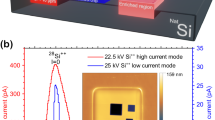Abstract
The high-resolution performance of 100-kV transmission electron microscopes has improved dramatically in the past few years. Use of an objective lens with a spherial aberration coefficient Cs of 0.7 mm and a low incident beam divergence (α = 0.2 mrad) allows point-to-point resolutions shown by Bursill and Wood1 to be ∼1.6 Å. These authors, however, distinguish between this ‘instrumental’ resolution and the resolution which can in principle be used for direct structural resolution and interpretation—only slightly better than 3 Å in the above conditions. The function sin χ, the part of the lens transfer function most directly dependent on the phase changes χ of the electrons as a function of lens defocus and spherical aberration, shows rapid oscillations for spacings smaller than ∼2.8 Å even for the optimum defocus condition for which sin χ is apparently −1 over a maximum range of spacings1. Thus even if point-to-point resolutions in the 2–3 Å range are obtained, by careful limitation of the beam divergence, the images can only be related to the structure by very careful comparison with computed images. It is this fact and the limited improvement to be expected on any further reduction of Cs, as well as the severe geometric limitations imposed on specimen manipulation in such lenses, which has lead to the approach of using increased accelerating voltages with a concomitant reduction in electron wavelength, λ: the above ‘structure resolution’ limit is approximately 0.7Cs¼λ¾. Most of the high-resolution work to date has concentrated on the examination of materials in which there are strong projected charge distribution periodicities at relatively coarse spacings. To obtain further information on the difficulties involved in the examination of defects in metals (with generally smaller spacings of the important charge projec tions) we have studied the degree to which images of the ordered alloy Ag3Mg can be related to naive descriptions of the projected charge distribution.
This is a preview of subscription content, access via your institution
Access options
Subscribe to this journal
Receive 51 print issues and online access
$199.00 per year
only $3.90 per issue
Buy this article
- Purchase on Springer Link
- Instant access to full article PDF
Prices may be subject to local taxes which are calculated during checkout
Similar content being viewed by others
References
Burstill, L. A. & Wood, G. J. Phil. Mag. 38, 673–689 (1978).
Iijima, S. in 35th Proceedings of the Electron Microscopical Society of America (ed. Bailey, G. W.), 18–19 (Claitors, Baton Rouge, 1977).
Izui, K., Furuno, S., Nishida, T., Otsu, H. & Kuwabara, S. J. electron. Microsc. 27, 171–179 (1978).
Spence, J. H. C., O'Keefe, M. A. & Kolar, M. Optik 49, 307 (1977).
Portier, R., Gratias, D., Guynard, M. & Stobbs, W. M. Acta crystallogr. A (in the press).
Fujiwara, K. J. phys. Soc. Jap. 12, 7–13 (1957).
Bursill, L. A. & Wilson, A. R. Acta crystallogr. A 33, 672–675 (1977).
Portier, R., Gratias, D. & Stobbs, W. M. Phil. Mag. (in the press).
Bursill, L. A. & Barry, J. C. Phil. Mag. 36, 797–810 (1977).
Author information
Authors and Affiliations
Rights and permissions
About this article
Cite this article
Stobbs, W., Portier, R. A projected potential image of a defect in an ordered alloy?. Nature 281, 52–54 (1979). https://doi.org/10.1038/281052a0
Received:
Accepted:
Published:
Issue Date:
DOI: https://doi.org/10.1038/281052a0
This article is cited by
-
High resolution imaging of amorphous materials
Nature (1979)
Comments
By submitting a comment you agree to abide by our Terms and Community Guidelines. If you find something abusive or that does not comply with our terms or guidelines please flag it as inappropriate.



